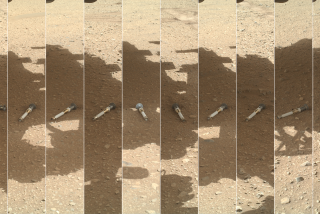NASA reveals finalists for next New Frontiers robotic mission: Saturn’s moon Titan or Rosetta spacecraft’s comet
- Share via
The field for NASA’s next New Frontiers mission is narrowing. Officials announced the two finalists for a new robotic explorer mission — one that would send a spacecraft to bring samples of the comet 67P/Churyumov-Gerasimenko to Earth, and another to explore Saturn’s moon Titan.
The two mission concepts, CAESAR and Dragonfly, detailed in a NASA briefing Wednesday, beat out 10 other proposals to explore solar system targets including a basin on the moon; the surface of Venus; and Enceladus, the icy ocean world that also circles Saturn.
“The New Frontiers program is really the premier program for our principal investigators and indeed it’s one of the most difficult programs to be selected for,” said Jim Green, director of the Planetary Science Division at NASA Headquarters in Washington. NASA only selects about two of these medium-class missions every decade, he added.
The comet mission CAESAR (or Comet Astrobiology Exploration Sample Return) would send a spacecraft back to comet 67P, explored by the European Space Agency’s Rosetta spacecraft and Philae lander in recent years. There, the craft would gather material from the nucleus of the comet and send it back to Earth for scientists to study in November 2038.
CAESAR is led by Steve Squyres of Cornell University, the principal investigator of NASA’s Opportunity rover, which has been studying Mars since 2004. The mission will be managed by NASA’s Goddard Space Flight Center; the sample return capsule will be provided by the Japanese space agency, JAXA, whose Hayabusa mission brought a similar capsule back from the asteroid Itokawa in 2010.
“Comets are among the most scientifically important objects in the solar system, but they’re also among the most poorly understood,” Squyres said.
Comets are the leftover building blocks of planets, and as such could reveal much about the solar system’s early development. They also are rich in water and organic molecules, essential for life, and may have been a source for these molecules on Earth.
And while comet 67P has been visited before, that actually helps scientists, who will have a map of where to safely send their spacecraft, he pointed out.
The Titan spacecraft, Dragonfly, is a dual-quadcopter that would explore landing sites on Saturn’s moon Titan, famous for its dark hydrocarbon lakes — long suggested as a potentially microbe-friendly world. The mission is led by Elizabeth Turtle from the Johns Hopkins University Applied Physics Laboratory.
Dragonfly would visit several locations tens and even hundreds of miles apart to study Titan’s surface and atmosphere. It could explore in depth some of the places where satellites like NASA’s Cassini spacecraft (may it rest in peace) have gotten only a distant glimpse.
Like CAESAR, Dragonfly would be making a repeat visit: Cassini’s Huygens probe landed on Titan in 2005 and studied the surface for less than a day. The robo-copter would take those studies much further, analyzing the moon’s organic chemistry and habitability and the geological processes at play.
“In this way we can evaluate how far prebiotic chemistry has progressed in an environment that we know has the ingredients for life — for water-based life or potentially even hydrocarbon-based life,” Turtle said.
These two missions have been selected for what’s called a Phase A concept study, Green said. The mission teams’ final proposals would be due in January 2019 and NASA would likely pick the winner that July. The winner would be slated for launch in the mid-2020s.
Whichever mission makes it to the launchpad will have big figurative shoes to fill. The last three New Frontiers missions were the New Horizons mission to Pluto, the Juno mission to Jupiter and the OSIRIS-REx mission now en route to the asteroid Bennu (and set to arrive in August 2018).
Follow @aminawrite on Twitter for more science news and “like” Los Angeles Times Science & Health on Facebook.







